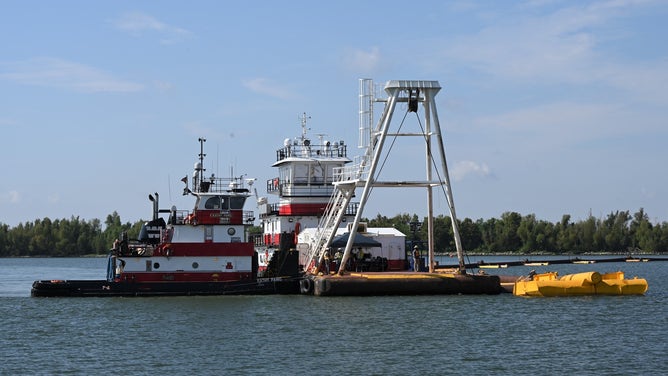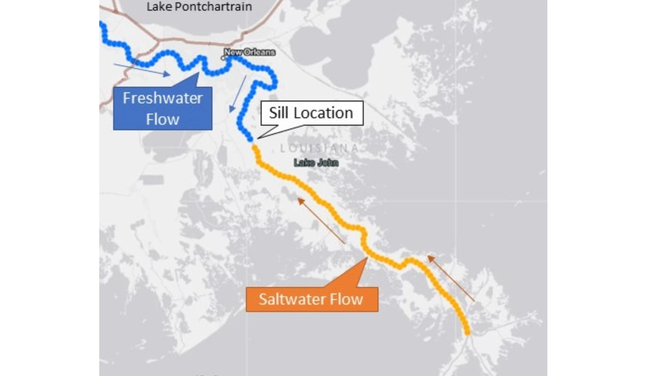Louisiana drinking water advisories lifted after salt water intrusion diluted to safe levels
Plaquemines Parish has been under a drinking water advisory since September when salt water from the Gulf of Mexico overtopped the underwater sill in the lower Mississippi River. Significant rainfall is still needed to increase the flow in the Mississippi.
Mississippi River levels plummet during extreme drought conditions
Substantial rain is needed in the Midwest and Southeast to help the flow in the lower Mississippi River. Drought conditions for more than 80% of Louisiana remain extreme to exceptional.
VENICE, La. – Louisiana residents in Plaquemines Parish are OK to drink their tap water again, according to parish government officials, after fresh water barges successfully dropped chloride amounts to safe drinking levels following an intrusion of salt water from the Gulf of Mexico.
The parish has been under a drinking water advisory since September, when salt water from the Gulf of Mexico overtopped the underwater sill in the lower Mississippi River.
A combination of drought, leading to low water levels along the Mississippi River, and high tides has helped allow salty seawater from the Gulf of Mexico to flow northward and impact drinking water supplies for communities in southeastern Louisiana. Efforts by the U.S. Army Corps of Engineers to hold back the salt water have been successful in slowing down the saltwater intrusion and potentially stopping it from reaching New Orleans water treatment facilities.
On Wednesday, parish officials said residents from Empire Bridge to Venice on the west bank of the Mississippi River and from Phoenix to Bohemia on the river's east bank are safe to resume using their tap water for drinking, cooking and bathing.

The J. S. Chatry contracted by the USACE New Orleans District for a dredge to build up the current sill in the lower Mississippi River to hold off the saltwater intrusion. (Image: U.S. Army Corps of Engineers New Orleans District)
(USACE)
"It is indeed a moment of relief, and we want to assure everyone that is it currently safe to consume water in all areas of Plaquemines Parish," a news release read.
According to the Department of Health, safe drinking levels of chloride are measured below 250 mg/l. The water at the treatment facilities serving Plaquemines Parish is "consistently" below that threshold as of Oct. 3, according to a news release.
Earlier this month, the U.S. Army Corps of Engineers began barging fresh water from an upstream location to water treatment facilities in Plaquemines Parish to dilute the salinity content to levels safe for water treatment.

U.S. Army Corps of Engineers New Orleans District map of the sill.
"As barges arrive at water treatment facilities, the fresh water will be transferred to storage or reservoir tanks and then mixed with salt water from the river to bring the chloride levels down below the threshold for treatment," the USACE said.
The U.S. Army Corps of Engineers built an additional 25 feet of an underwater barrier known as a "sill" in the Mississippi River to hold off the salt water.
As of the latest USACE New Orleans District update, the saltwater wedge is still expected to impact additional water treatment facilities. The wedge is expected to reach Belle Chasse on Nov. 13 and Dalcour by Nov. 18. Chloride levels are not expected to exceed 250 mg/l for water treatment centers north of Bell Chasse, according to the USACE timeline.
The USACE is working on the capability to deliver up to 36 million gallons of water per day if additional facilities are impacted by the saltwater intrusion on the Mississippi River.
Extreme drought conditions persist
For the second year in a row, drought along the Mississippi River Watershed reduced the flow of the lower Mississippi River, allowing the Gulf of Mexico to creep further north into the river.

Drought in the Mississippi River watershed.
Rain is needed in the Midwest and Southeast to create enough flow to hold off the salt water.
More than 80% of Louisiana is under extreme drought conditions, and 60% of the state is under exceptional drought, the most severe of the U.S. Drought Monitor scale.
Hurricane Norma, tracking toward Mexico, could bring promising rain to the Plains and the South, but one rain event won't be enough to end drought conditions on the Mississippi River.
